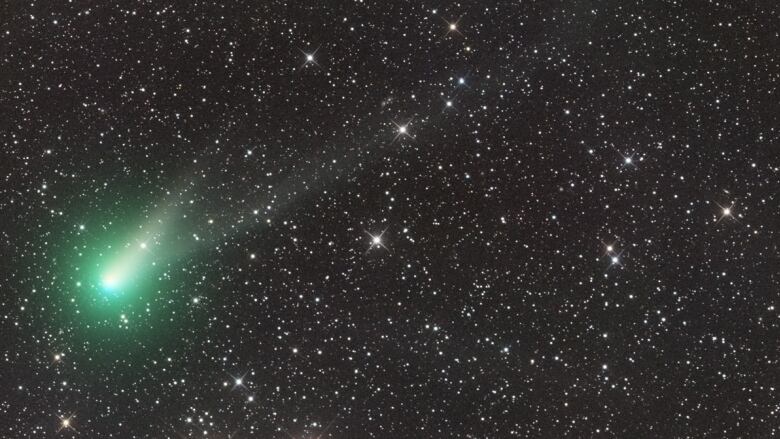Comet Catalina: Don't miss your only chance to see it
Comet makes its closest approach to Earth on Jan. 17

A green comet with two tails is passing through our skies, and looking for it may be a great way to ring in the New Year.
Comet Catalina, officially known as C/2013 US10 (Catalina), is currently making its first and only trip through the inner solar system.
The comet has been visible with binoculars in the northern hemisphere before dawn since late November, and makes its closest approach to Earth on Jan. 17. At that point, it will be near the handle of the Big Dipper.
At the moment, it is gradually moving higher in the sky and appearing earlier before dawn, making it easier to see, and it will be particularly easy to find on the morning of Jan. 1.
Comet Catalina can now be seen in the early morning sky with binoculars or the unaided eye from dark sites. pic.twitter.com/SCTZLtuNZ2
—@astroeducatorThat night, it will appear near the bright star Arcturus in the constellation Bootes in the eastern sky, left of and a little bit lower than the moon.
Royal Astronomical Society of Canada member Michael Watson says the bright quarter moon on Jan. 1 may make the comet quite difficult to spot.
But viewing will be much better on Jan. 8-10, when there will be no moon in the early morning sky and the comet will be very close to earth, he said.
"What people will see with binoculars over the next few weeks is this fuzzy blob in the sky, a bit of colour to it, little bit green," said Gary Boyle, an Ottawa-based astronomer who runs the site wondersofastronomy.com, in a recent interview with CBC Ottawa's In Town and Out.

While you may not be able to see the comet's two tails yourself, they will be visible if you take a photo with your digital camera, Boyle says.
"Any kind of digital camera now can take some pretty impressive shots of this comet."
Comet Catalina Loc: Terrebonne, Quebec, Canada - Rock Levesque pic.twitter.com/cutXaqyEwU
—@ObsDeLavalHe recommends using a tripod, setting your ISO to 1600 and using a 30-second exposure.
Comet Catalina, which is less than 20 kilometres across, was discovered in 2013 by the Tuscon, Ariz.-based Catalina Sky Survey, which looks for potentially hazardous near-Earth objects. At first, it was thought to be a very large near-Earth asteroid. But astronomers soon realized it was actually a very long, near-parabolic orbit and observations with the Canada-France-Hawaii telescope showed "modest cometary activity."
Originally, astronomers had hoped the comet would become visible to the naked eye once it came close to the sun. That hasn't happened yet.
As of mid-December, the comet was a little fainter than magnitude 6, the Canadian astronomy website SkyNews reported. That's just beyond the range of naked eye visibility. The faintest stars visible in rural areas are magnitude 5 (and the lower the number, the brighter an object is).
Boyle says the comet could still have an "outburst" of dust and gas and become suddenly brighter.
Astronomers think the comet originally came in from the Oort cloud, a region full of icy objects such as comets in the distant reaches of the solar system, after its orbit was perturbed by other objects. Now that it has swung past the sun, its current path is expected to permanently eject it from the solar system.












_(720p).jpg)


 OFFICIAL HD MUSIC VIDEO.jpg)
.jpg)



























































































